Triple Collocation Analysis for Two Error-Correlated Datasets: Application to L-Band Brightness Temperatures over Land
Abstract
1. Introduction
2. Data and Methods
2.1. Triple Collocation for Two Error-Correlated Measurements
2.1.1. Settings and Notation
2.1.2. Least Squared Error Triple Collocation (LSETC)
2.1.3. Correlated Triple Collocation (CTC)
2.2. Generation of Synthetic Data
- i
- The sampling size of the series of triplets, N.
- ii
- The correlation between the errors of the measurements and .
- iii
- The differences in the standard deviations of the three error measurements , , and :
- -
- Case 1 (“small uncorrelated”): The measurement with uncorrelated error has an error standard deviation significantly lower than the other two measurements (, , and ).
- -
- Case 2 (“equal”): All errors are considered equal ().
- -
- Case 3 (“large uncorrelated”): The measurement with uncorrelated error has an error standard deviation significantly higher than the other two measurements (, , and ).
2.3. Analysis on the Intercalibration Factors
2.4. L-Band Brightness Temperatures over Land
2.4.1. Nodal Sampling: Reduction of RFI Contamination in SMOS Images
2.4.2. SMOS Brightness Temperatures
2.4.3. SMAP Brightness Temperatures
2.4.4. Spatiotemporally Collocated TB Maps
2.4.5. Effective Spatial Resolutions of SMOS and SMAP TB Maps
3. Results and Discussion
3.1. Synthetic Experiments on Error-Correlated Triplets
- Fraction of valid retrievals is the ratio of the total valid retrievals (that is, nonnegative estimates of the error variances ) to the total number of realizations. The closer to 1, the better.
- Bias is the difference between the average of all valid estimates of the error standard deviations and the value used for the generation of the dataset. The closer to 0, the better. It provides the bias in our estimates of . Positive bias indicates that the error is overestimated, and negative bias indicates that it is sub-estimated.
- Uncertainty is the standard deviation of the valid estimates of error standard deviations. The closer to 0, the better. It provides the accuracy in our estimates of .
- The fraction of valid points is very large even for scarce samplings () for the measurements with the largest error standard deviations. The number of valid retrievals for the “small uncorrelated case” and “large uncorrelated case” is lower for the measurement with the lowest error standard deviation: in the range of 60% for scarce sampling and increasing slowly for larger sampling sizes. CTC has in general a larger number of valid retrievals than LSETC, especially in the “small uncorrelated case” and less in the “large uncorrelated case”. The fractions of valid points for LSETC and CTC are very similar in the “equal case”.
- Biases are not very large in the “small uncorrelated case” and “equal case”. Even for scarce samplings (), they are at most about 10% of the largest error standard deviation for the CTC and about 20% for the LSETC. The situation is worse in the “large uncorrelated case”, where it has 30% of the largest error standard deviation (both for CTC and LSETC) for scarce sampling and only attains 10% for good sampling () or better. In most cases, the performance in terms of biases of CTC is better than that of LSETC.
- The measurement with the smallest error standard deviation has always a positive bias in CTC, indicating that its error standard deviation is always overestimated. This bias is reduced rapidly as sampling size N increases. In the “equal case”, biases are negligible for the three measurements even for scarce sampling.
- Uncertainties are small in the “small uncorrelated case” and moderate in the other two cases. In the two latest cases, we expect uncertainties to be around 10% of the largest error standard deviation even with excellent samplings (). CTC outperforms LSETC, especially in the “small uncorrelated case”.
- From the experiments, we see that the dependence of all metrics on the value of the error correlation is weak in most cases. For the “small uncorrelated case”, the bias and uncertainty decrease at high correlation values for CTC, since the two measurements with larger errors become essentially the same, but in all cases, CTC outperforms LSETC. Hence, CTC is very robust independently of the degree of correlation between those errors.
3.1.1. Impact of Statistical Fluctuations on the Estimation of Intercalibration Factors
3.1.2. Sensitivity Analysis of the Estimated Error Variances to Changes in the Intercalibration Factors
3.2. Error Characterization of Satellite L-Band Brightness Temperatures over Land
3.2.1. Inferring SMAP Errors Overestimate Gaps
4. Conclusions
Author Contributions
Funding
Acknowledgments
Conflicts of Interest
Appendix A. Triple Collocation with Two Error-Correlated Datasets: Theoretical Basis
Appendix A.1. Case of Three Variables with Independent Measurement Errors
Appendix A.2. Two Measurements with Correlated Errors but Uncorrelated from a Known Third Measurement: Least Squared Error Triple Collocation
Appendix A.3. Two Measurements with Correlated Errors but Uncorrelated from a Known Third Measurement: Correlated Triple Collocation
Appendix A.4. Discussion on the Quality of the Error Estimates Using Correlated Triple Collocation
References
- Stoffelen, A. Toward the true near-surface wind speed: Error modeling and calibration using triple collocation. J. Geophys. Res. 1998, 103, 7755–7766. [Google Scholar] [CrossRef]
- Lin, W.; Portabella, M.; Stoffelen, A.; Vogelzang, J.; Verhoef, A. On mesoscale analysis and ASCAT ambiguity removal. Q. J. R. Meteorol. Soc. 2016, 142, 1745–1756. [Google Scholar] [CrossRef]
- Dorigo, W.A.; Scipal, K.; Parinussa, R.M.; Liu, Y.Y.; Wagner, W.; de Jeu, R.A.M.; Naeimi, V. Error characterisation of global active and passive microwave soilmoisture datasets. Hydrol. Earth Syst. Sci. 2010, 14, 2605–2616. [Google Scholar] [CrossRef]
- Pierdicca, N.; Fascetti, F.; Pulvirenti, L.; Crapolicchio, R.; Muñoz-Sabater, J. Quadruple Collocation Analysis for Soil Moisture Product Assessment. IEEE Geosci. Remote Sens. Lett. 2015, 12, 1595–1599. [Google Scholar] [CrossRef]
- Gruber, A.; Su, C.H.; Crow, W.T.; Zwieback, S.; Dorigo, W.A.; Wagner, W. Estimating error cross-correlations in soil moisture data sets using extended collocation analysis. J. Geophys. Res. Atmos. 2016, 121, 1208–1219. [Google Scholar] [CrossRef]
- Pierdicca, N.; Fascetti, F.; Pulvirenti, L.; Crapolicchio, R. Error Characterization of Soil Moisture Satellite Products: Retrieving Error Cross-Correlation Through Extended Quadruple Collocation. IEEE J. Sel. Top. Appl. Earth Obs. Remote Sens. 2017, 10, 4522–4530. [Google Scholar] [CrossRef]
- Ratheesh, S.; Mankad, B.; Basu, S.; Kumar, R.; Sharma, R. Assessment of Satellite-Derived Sea Surface Salinity in the Indian Ocean. IEEE Geosci. Remote Sens. Lett. 2013, 10, 428–431. [Google Scholar] [CrossRef]
- Hoareau, N.; Portabella, M.; Lin, W.; Ballabrera-Poy, J.; Turiel, A. Error Characterization of Sea Surface Salinity Products Using Triple Collocation Analysis. IEEE Trans. Geosci. Remote Sens. 2018, 56, 5160–5168. [Google Scholar] [CrossRef]
- Gruber, A.; De Lannoy, G.; Albergel, C.; Al-Yaari, A.; Brocca, L.; Calvet, J.C.; Colliander, A.; Cosh, M.; Crow, W.; Dorigo, W.; et al. Validation practices for satellite soil moisture retrievals: What are (the) errors? Remote Sens. Environ. 2020, 244, 111806. [Google Scholar] [CrossRef]
- González-Gambau, V.; Turiel, A.; Olmedo, E.; Martínez, J.; Corbella, I.; Camps, A. Nodal Sampling: A New Image Reconstruction Algorithm for SMOS. IEEE Trans. Geosci. Remote Sens. 2016, 54, 2314–2328. [Google Scholar] [CrossRef]
- González-Gambau, V.; Olmedo, E.; Turiel, A.; Martínez, J.; Ballabrera-Poy, J.; Portabella, M.; Piles, M. Enhancing SMOS brightness temperatures over the ocean using the nodal sampling image reconstruction technique. Remote Sens. Environ. 2016, 180, 205–220. [Google Scholar] [CrossRef]
- Scipal, K.; Holmes, T.; de Jeu, R.; Naeimi, V.; Wagner, W. A Possible Solution for the Problem of Estimating the Error Structure of Global Soil Moisture Data Sets. Geophys. Res. Lett. 2008, 35. [Google Scholar] [CrossRef]
- Su, C.H.; Ryu, D.; Crow, W.T.; Western, A.W. Beyond Triple Collocation: Applications to Soil Moisture Monitoring. J. Geophys. Res. Atmos. 2014, 119, 6419–6439. [Google Scholar] [CrossRef]
- Yilmaz, M.T.; Crow, W.T. The Optimality of Potential Rescaling Approaches in Land Data Assimilation. J. Hydrometeorol. 2013, 14, 650–660. [Google Scholar] [CrossRef]
- Vogelzang, J.; Stoffelen, A.; Verhoef, A.; Figa-Saldaña, J. On The Quality of High-Resolution Scatterometer Winds. J. Geophys. Res. Ocean. 2011, 116. [Google Scholar] [CrossRef]
- Martín-Neira, M.; Oliva, R.; Corbella, I.; Torres, F.; Duffo, N.; Durán, I.; Kainulainen, J.; Closa, J.; Zurita, A.; Cabot, F.; et al. SMOS instrument performance and calibration after six years in orbit. Remote Sens. Environ. 2016, 180, 19–39. [Google Scholar] [CrossRef]
- Oliva, R.; Daganzo, E.; Richaume, P.; Kerr, Y.; Cabot, F.; Soldo, Y.; Anterrieu, E.; Reul, N.; Gutierrez, A.; Barbosa, J.; et al. Status of Radio Frequency Interference (RFI) in the 1400-1427 MHz passive band based on six years of SMOS mission. Remote Sens. Environ. 2016, 180, 64–75. [Google Scholar] [CrossRef]
- González-Gambau, V.; Olmedo, E.; Martínez, J.; Turiel, A.; Durán, I. Improvements on Calibration and Image Reconstruction of SMOS for Salinity Retrievals in Coastal Regions. IEEE J. Sel. Top. Appl. Earth Obs. Remote Sens. 2017, 10, 3064–3078. [Google Scholar] [CrossRef]
- Zine, S.; Boutin, J.; Font, J.; Reul, N.; Waldteufel, P.; Gabarró, C.; Tenerelli, J.; Petitcolin, F.; Vergely, J.; Talone, M.; et al. Overview of the SMOS Sea Surface Salinity Prototype Processor. IEEE Trans. Geosci. Remote Sens. 2008, 46, 621–645. [Google Scholar] [CrossRef]
- Olmedo, E.; González-Gambau, V.; Turiel, A.; Guimbard, S.; González-Haro, C.; Martínez, J.; Gabarró, C.; Portabella, M.; Arias, M.; Sabia, R.; et al. Towards an enhanced SMOS Level 2 Ocean Salinity product. IEEE J. Sel. Top. Appl. Earth Obs. Remote. Sens. 2020. in review. [Google Scholar]
- Kerr, Y.H.; Waldteufel, P.; Richaume, P.; Wigneron, J.P.; Ferrazzoli, P.; Mahmoodi, A.; Al Bitar, A.; Cabot, F.; Gruhier, C.; Juglea, S.E.; et al. The SMOS Soil Moisture Retrieval Algorithm. IEEE Trans. Geosci. Remote Sens. 2012, 50, 1384–1403. [Google Scholar] [CrossRef]
- Wigneron, J.P.; Jackson, T.; O’Neill, P.; Lannoy, G.D.; de Rosnay, P.; Walker, J.; Ferrazzoli, P.; Mironov, V.; Bircher, S.; Grant, J.; et al. Modelling the passive microwave signature from land surfaces: A review of recent results and application to the L-band SMOS & SMAP soil moisture retrieval algorithms. Remote Sens. Environ. 2017, 192, 238–262. [Google Scholar] [CrossRef]
- SMOS ESL Level 1. Read-Me-First Note for the Release of the SMOS Level 1 Data Products; Technical Report; European Space Agency: Paris, France, 2015. [Google Scholar]
- SMOS DPGS. SMOS Level 1 and Auxiliary Data Products Specifications, SO-TN-IDR-GS-0005, v5/31; Technical Report; Indra Sistemas, S.A.: Alcobendas, Spain, 2014. [Google Scholar]
- Gutiérrez, A.; Castro, R.; Vieira, P.; Barbosa, J. SMOS L1 Processor L1C Data Processing Model, SO-DS-DME-L1OP-0009, Issue 2.14; Technical Report; Deimos Engenharia: Lisbon, Portugal, 2014. [Google Scholar]
- Talone, M.; Portabella, M.; Martínez, J.; González-Gambau, V. About the Optimal Grid for SMOS Level 1C and Level 2 Products. IEEE Geosci. Remote Sens. Lett. 2015, 12, 1630–1634. [Google Scholar] [CrossRef]
- Martin-Neira, M.; Ribo, S.; Martin-Polegre, A.J. Polarimetric mode of MIRAS. IEEE Trans. Geosci. Remote Sens. 2002, 40, 1755–1768. [Google Scholar] [CrossRef]
- Snyder, J. Map Projections—A Working Manual. U.S. Geological Survey Professional Paper 1395; Technical Report; U.S. Government Printing Office: Washington, DC, USA, 1987.
- Bindlish, R.; Jackson, T.J.; Chan, S.; Colliander, A.; Kerr, Y. Integration of SMAP and SMOS L-band observations. In Proceedings of the 2017 IEEE International Geoscience and Remote Sensing Symposium (IGARSS), Fort Worth, TX, USA, 23–28 July 2017; pp. 2546–2549. [Google Scholar] [CrossRef]
- De Lannoy, G.J.M.; Reichle, R.H.; Peng, J.; Kerr, Y.; Castro, R.; Kim, E.J.; Liu, Q. Converting Between SMOS and SMAP Level-1 Brightness Temperature Observations Over Nonfrozen Land. IEEE Geosci. Remote Sens. Lett. 2015, 12, 1908–1912. [Google Scholar] [CrossRef]
- Piepmeier, J.R.; Johnson, J.T.; Mohammed, P.N.; Bradley, D.; Ruf, C.; Aksoy, M.; Garcia, R.; Hudson, D.; Miles, L.; Wong, M. Radio-Frequency Interference Mitigation for the Soil Moisture Active Passive Microwave Radiometer. IEEE Trans. Geosci. Remote Sens. 2014, 52, 761–775. [Google Scholar] [CrossRef]
- Mohammed, P.N.; Aksoy, M.; Piepmeier, J.R.; Johnson, J.T.; Bringer, A. SMAP L-Band Microwave Radiometer: RFI Mitigation Prelaunch Analysis and First Year On-Orbit Observations. IEEE Trans. Geosci. Remote Sens. 2016, 54, 6035–6047. [Google Scholar] [CrossRef]
- Piepmeier, J.R.; Mohammed, P.; Peng, J.; Kim, E.J.; Amici, G.D.; Ruf, C. SMAP L1B Radiometer Half-Orbit Time-Ordered Brightness Temperatures, Version 3; Technical Report; NASA National Snow and Ice Data Center Distributed Active Archive Center: Boulder, CO, USA, 2016. [CrossRef]
- Piepmeier, J.R.; Mohammed, P.; Amici, G.D.; Kim, E.J.; Peng, J.; Ruf, C. Algorithm Theoretical Basis Document; Technical Report; NASA/GSFC: Washington, DC, USA, 2016.
- Hoareau, N.; Turiel, A.; Portabella, M.; Ballabrera-Poy, J.; Vogelzang, J. Singularity Power Spectra: A Method to Assess Geophysical Consistency of Gridded Products 2014 Application to Sea-Surface Salinity Remote Sensing Maps. IEEE Trans. Geosci. Remote Sens. 2018, 56, 5525–5536. [Google Scholar] [CrossRef]
- González-Gambau, V.; Olmedo, E.; Martínez, J.; Turiel, A.; Corbella, I.; Oliva, R.; Martín-Neira, M. Benefits of Applying Nodal Sampling to SMOS Data Over Semi-Enclosed Seas and Strongly RFI-Contaminated Regions. In Proceedings of the IGARSS 2018-2018 IEEE International Geoscience and Remote Sensing Symposium, Valencia, Spain, 22–27 July 2018; pp. 305–308. [Google Scholar] [CrossRef]
- Castillo, M.; Uranga, E. ESAC RFI survey in the SMOS 1400-1427 MHz passive band. In Proceedings of the ESA Living Planet Symposium, Prague, Czech Republic, 9–13 May 2016. [Google Scholar]
- Olmedo, E.; González-Haro, C.; Hoareau, N.; Umbert, M.; González-Gambau, V.; Martínez, J.; Gabarró, C.; Turiel, A. Nine Years of SMOS Sea Surface Salinity Global Maps at the Barcelona Expert Center. Earth System Science Data, in Discussion. 2020. Available online: https://essd.copernicus.org/preprints/essd-2020-232/ (accessed on 14 September 2020).
- Oliva, R.; González-Gambau, V.; Turiel, A. Assessment of SMOS RFI mitigation by means of a triple collocation technique. In Proceedings of the IGARSS 2019–2019 IEEE International Geoscience and Remote Sensing Symposium, Yokohama, Japan, 28 July 28–2 August 2019; pp. 4543–4546. [Google Scholar]

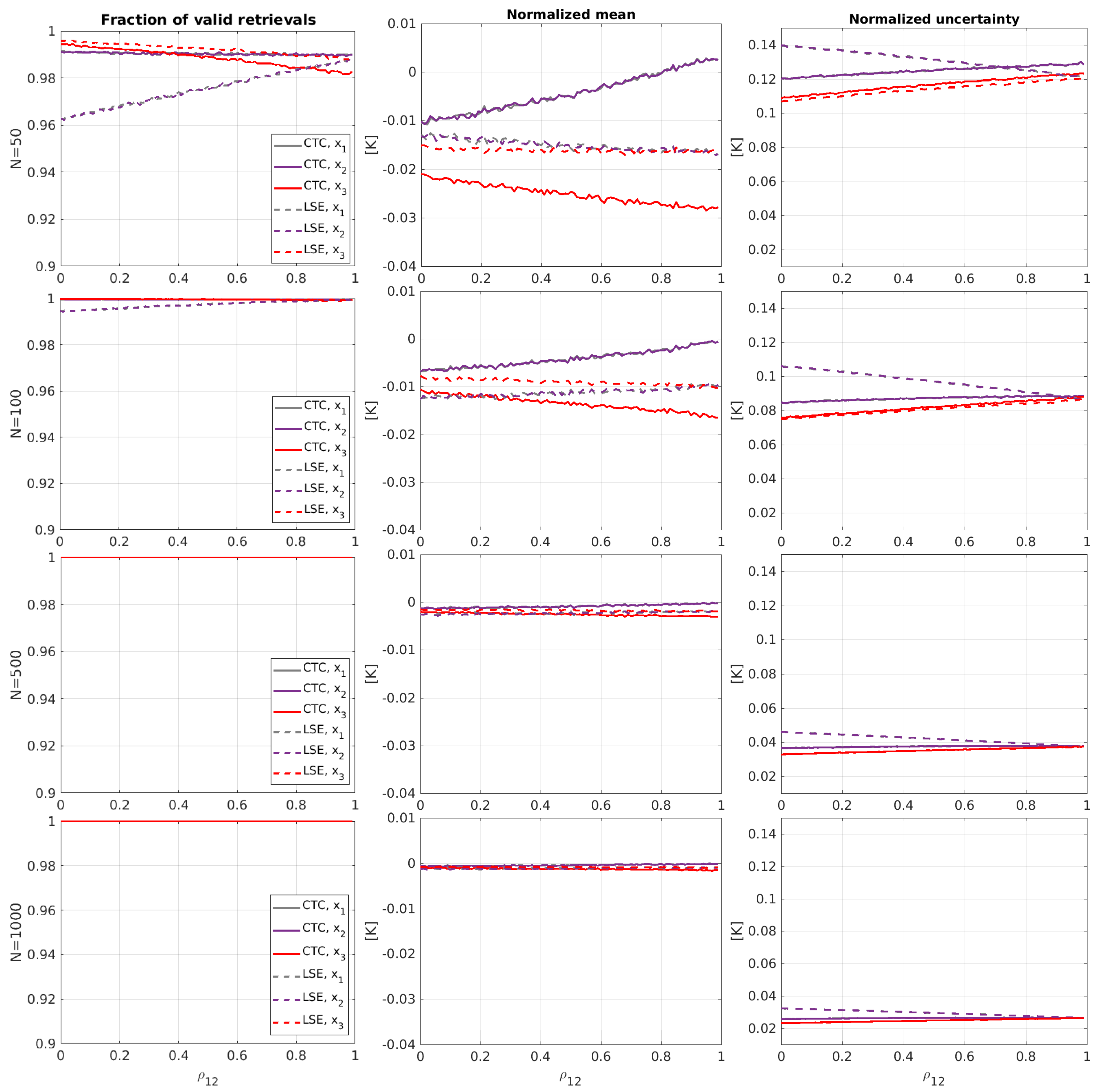
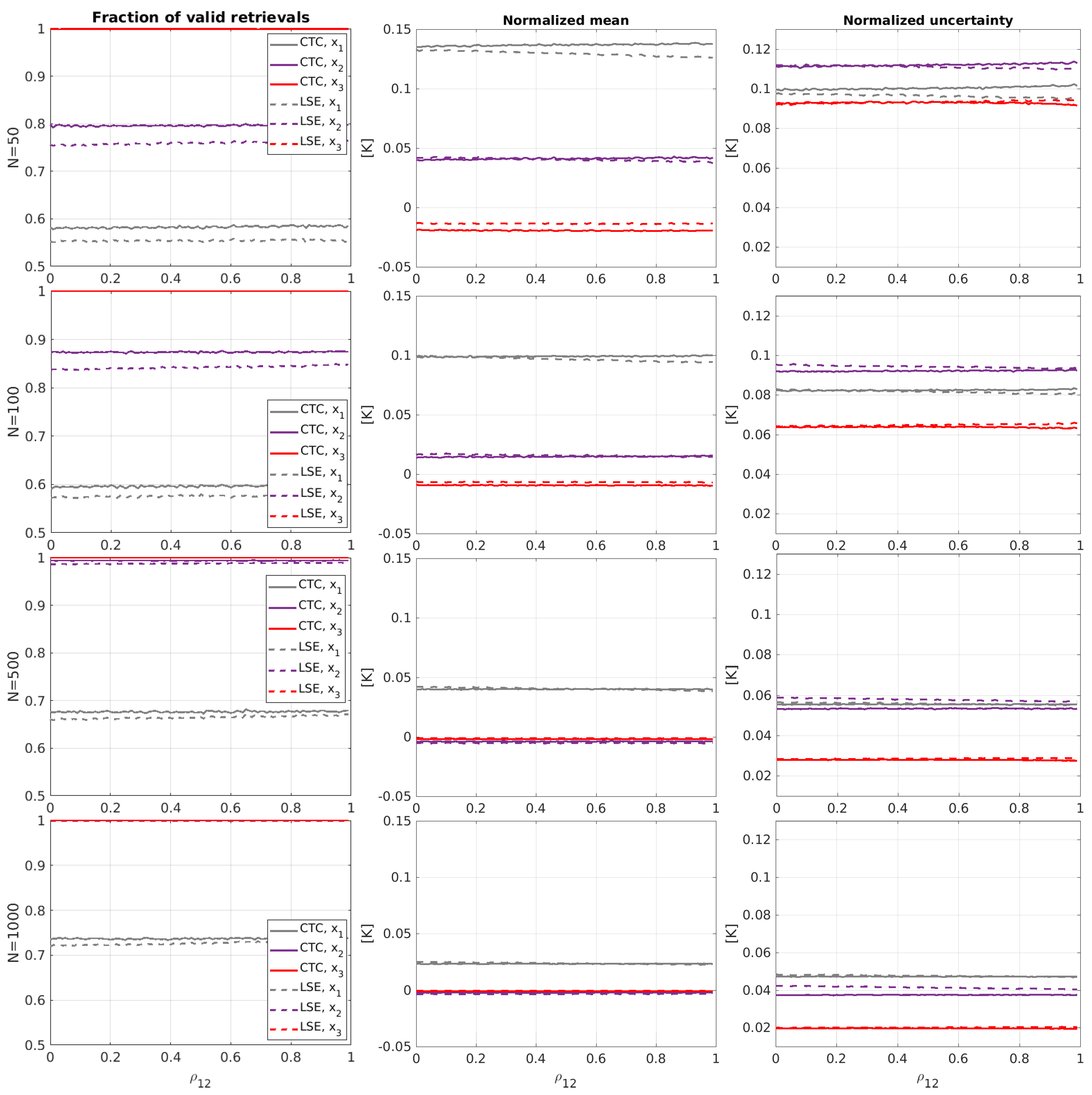



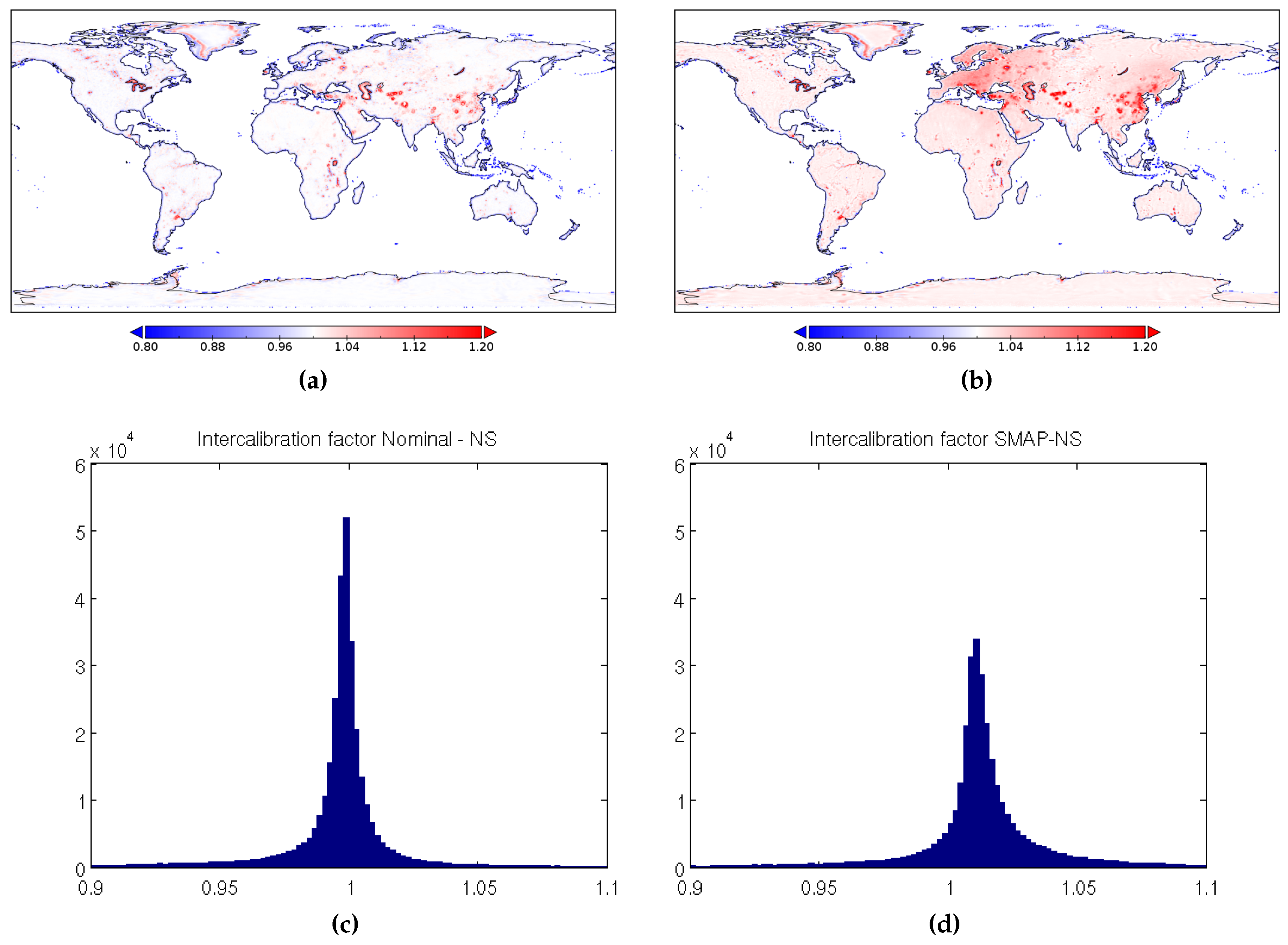
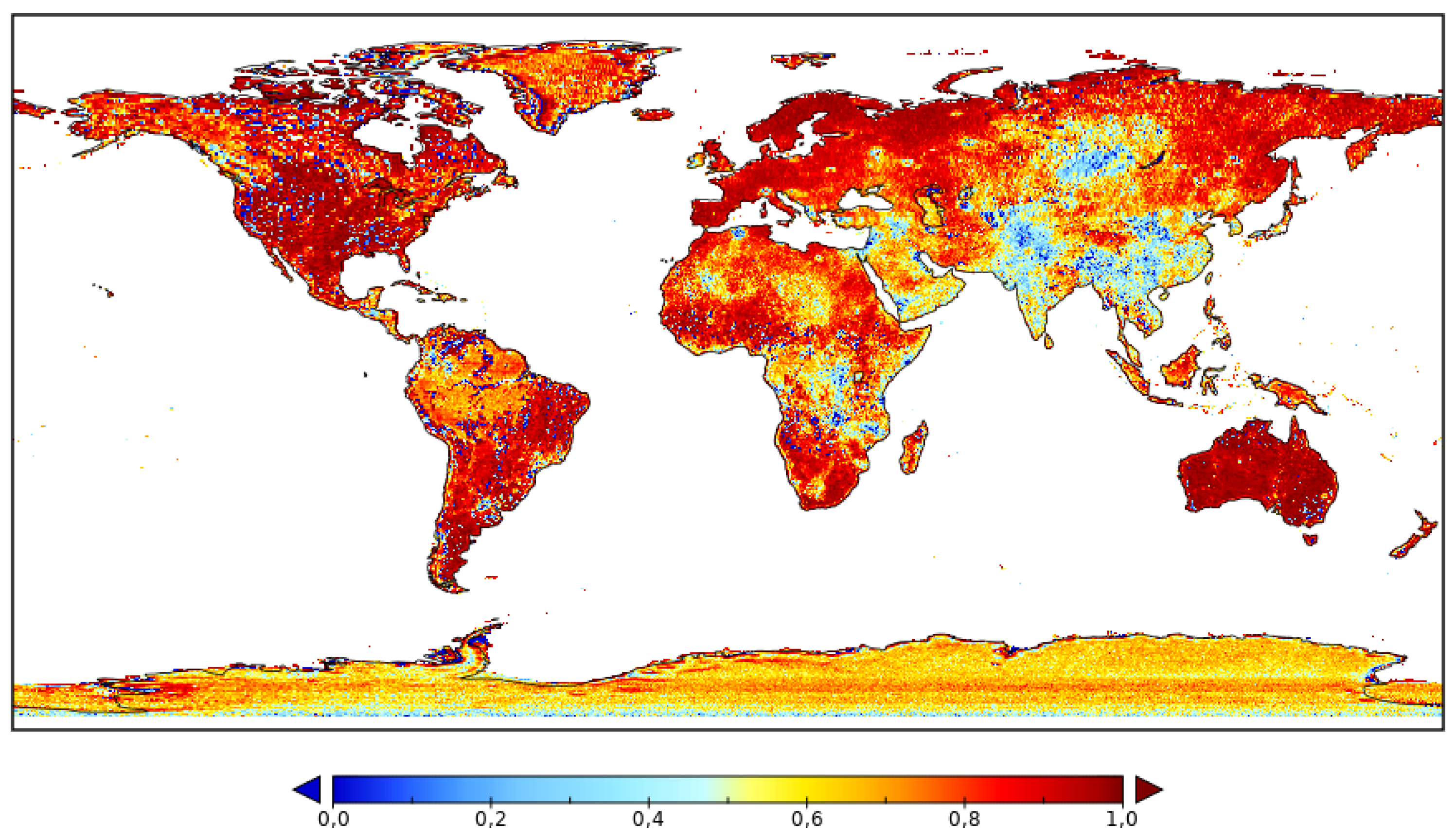

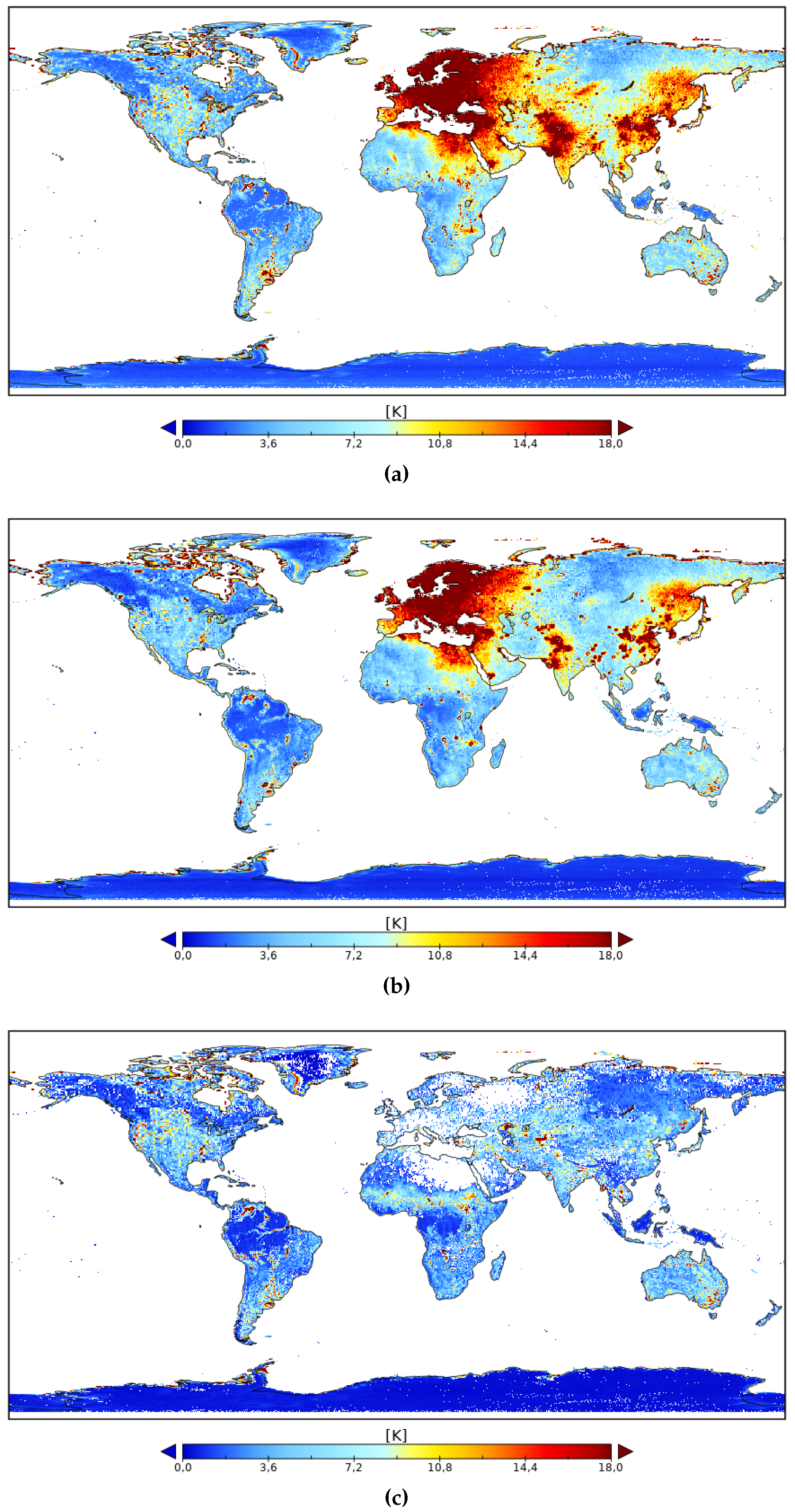



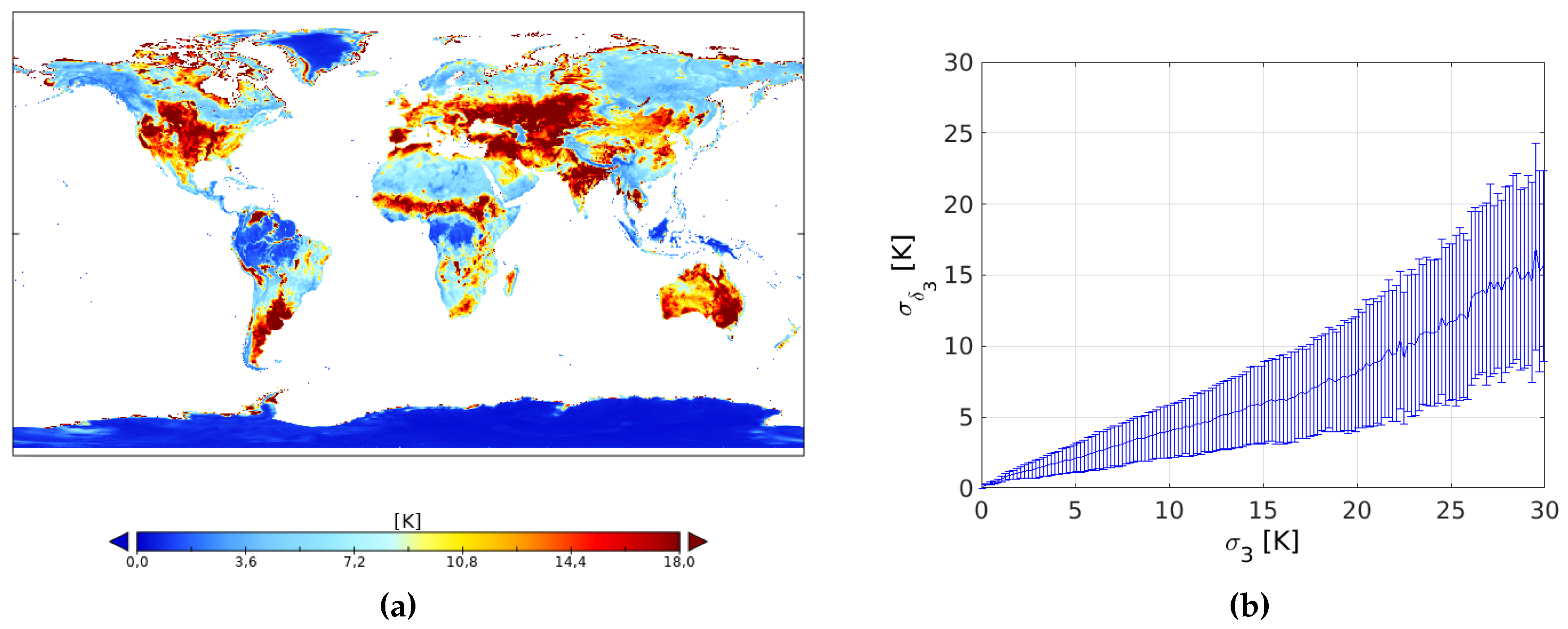
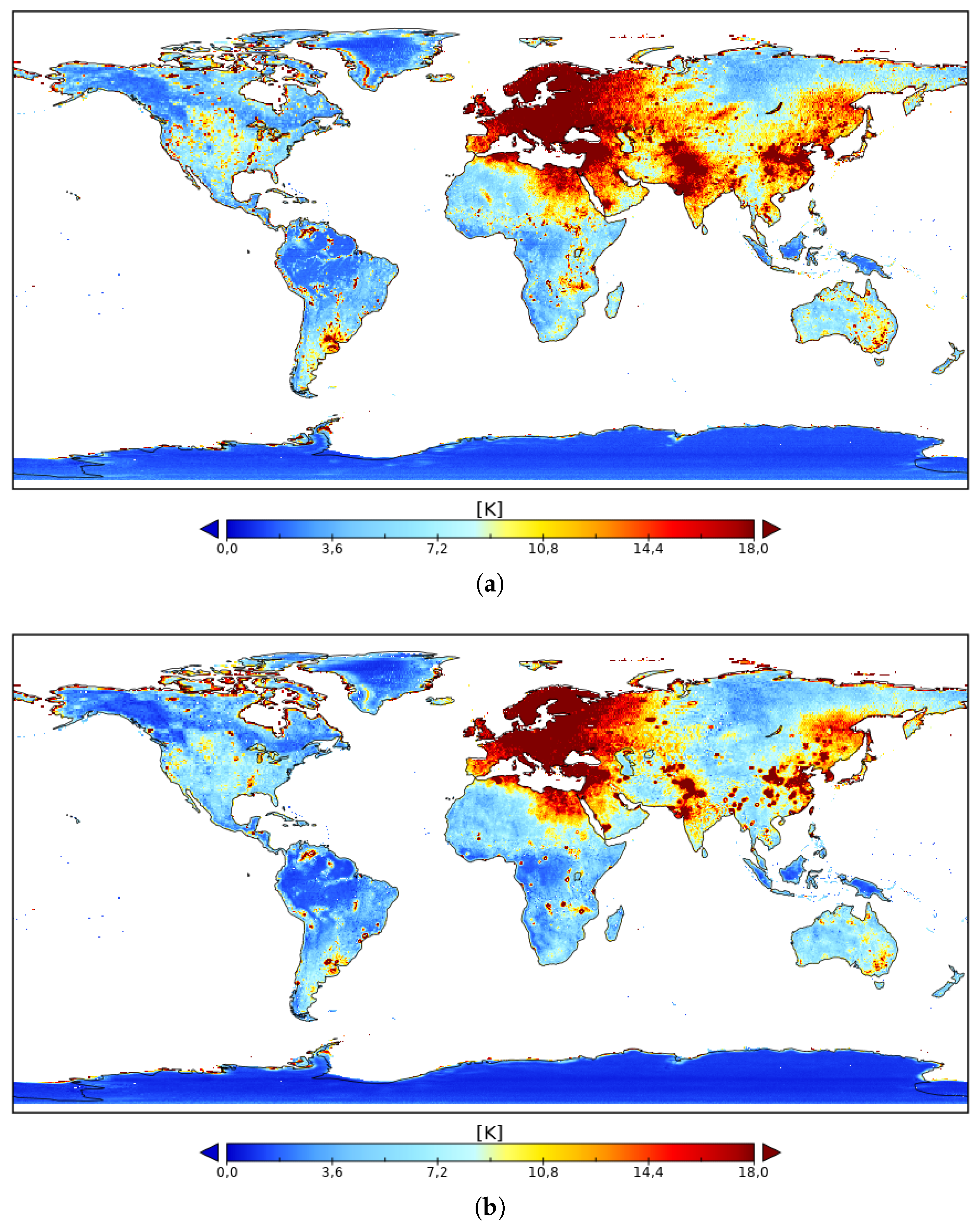
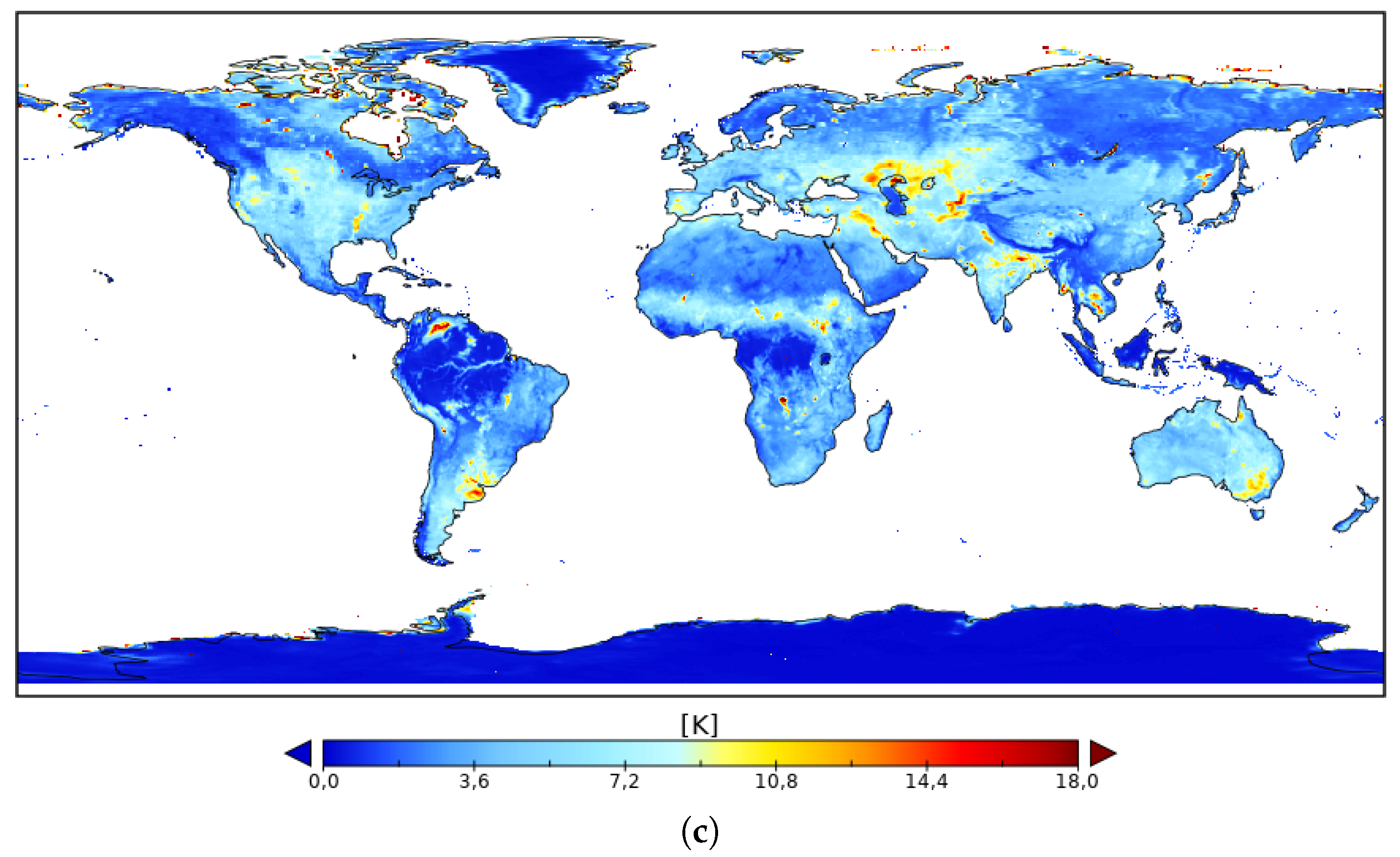
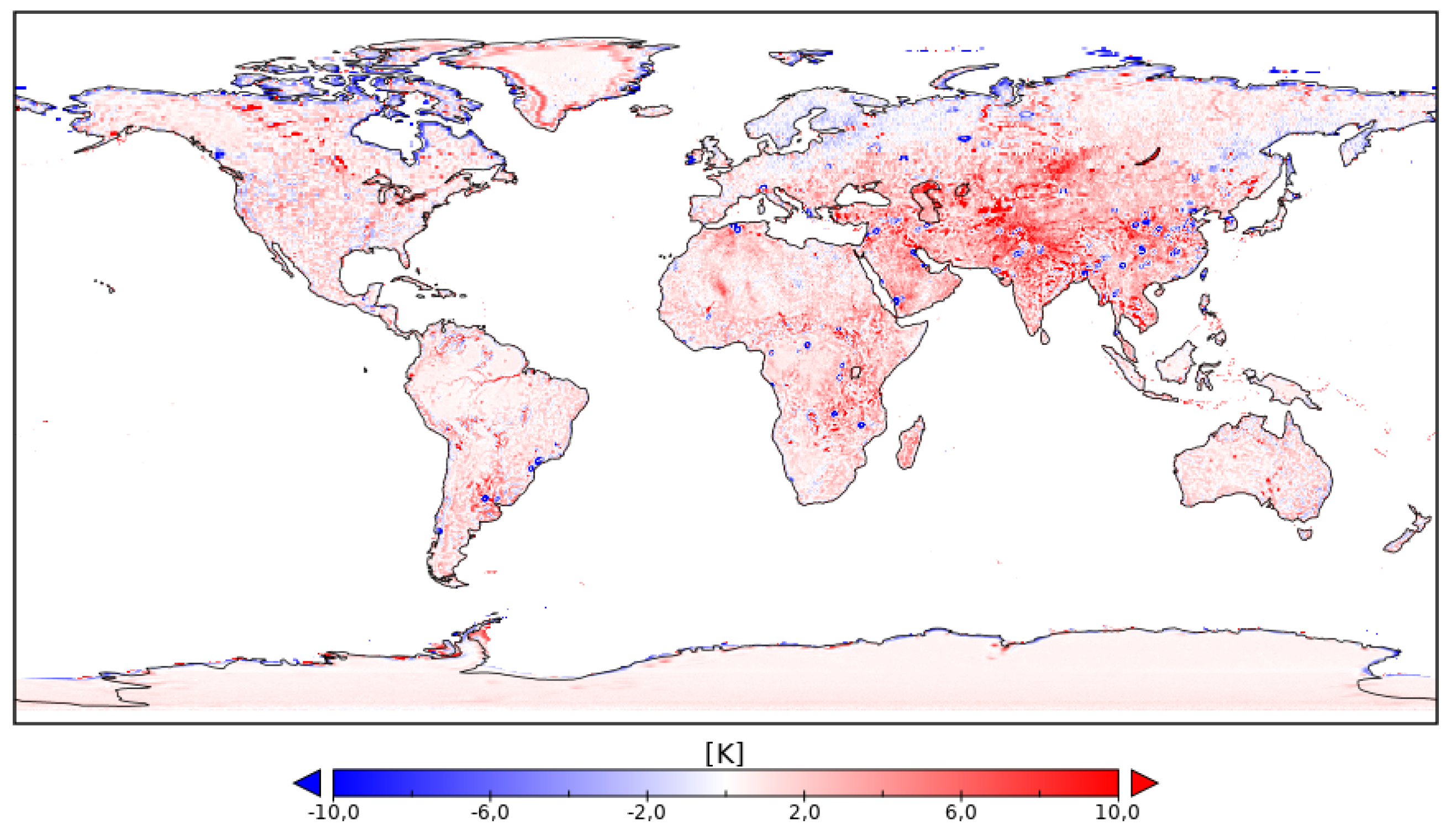
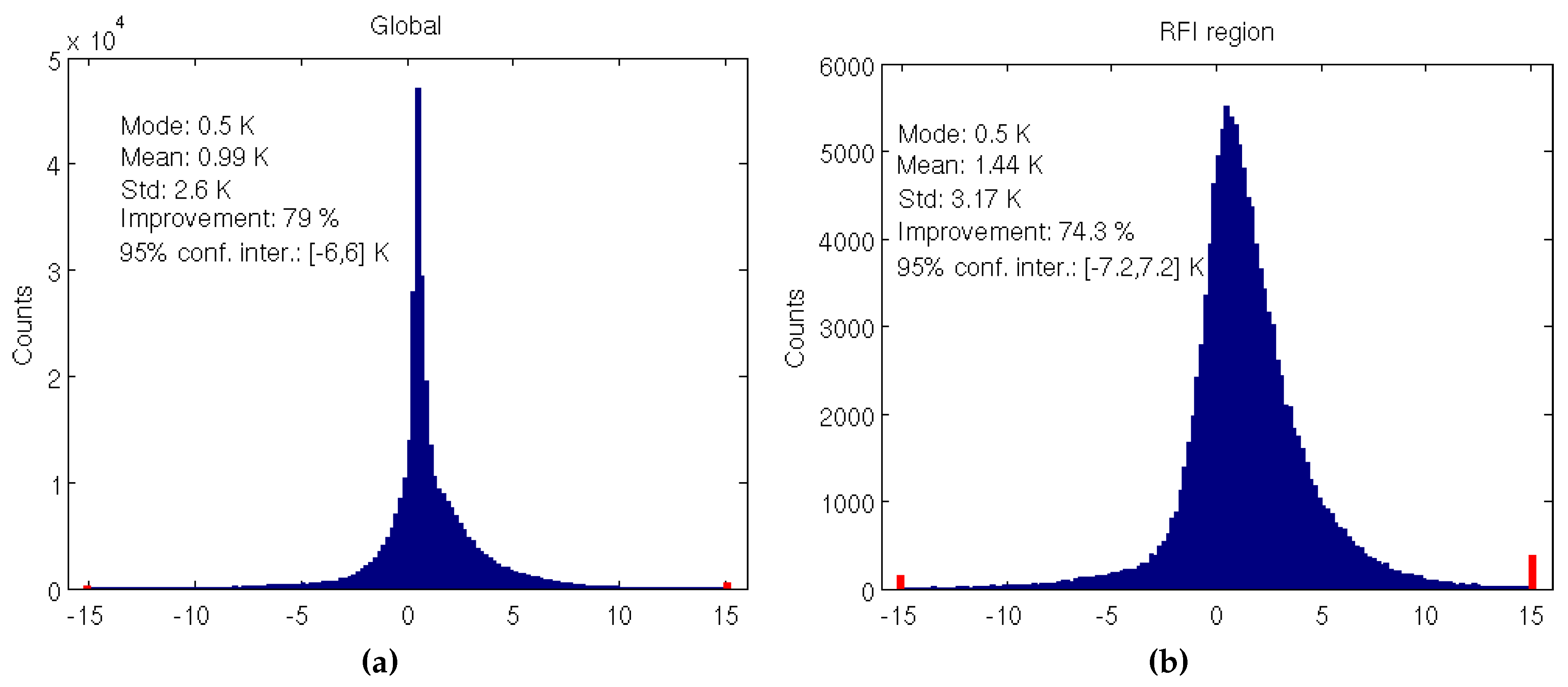
Publisher’s Note: MDPI stays neutral with regard to jurisdictional claims in published maps and institutional affiliations. |
© 2020 by the authors. Licensee MDPI, Basel, Switzerland. This article is an open access article distributed under the terms and conditions of the Creative Commons Attribution (CC BY) license (http://creativecommons.org/licenses/by/4.0/).
Share and Cite
González-Gambau, V.; Turiel, A.; González-Haro, C.; Martínez, J.; Olmedo, E.; Oliva, R.; Martín-Neira, M. Triple Collocation Analysis for Two Error-Correlated Datasets: Application to L-Band Brightness Temperatures over Land. Remote Sens. 2020, 12, 3381. https://doi.org/10.3390/rs12203381
González-Gambau V, Turiel A, González-Haro C, Martínez J, Olmedo E, Oliva R, Martín-Neira M. Triple Collocation Analysis for Two Error-Correlated Datasets: Application to L-Band Brightness Temperatures over Land. Remote Sensing. 2020; 12(20):3381. https://doi.org/10.3390/rs12203381
Chicago/Turabian StyleGonzález-Gambau, Verónica, Antonio Turiel, Cristina González-Haro, Justino Martínez, Estrella Olmedo, Roger Oliva, and Manuel Martín-Neira. 2020. "Triple Collocation Analysis for Two Error-Correlated Datasets: Application to L-Band Brightness Temperatures over Land" Remote Sensing 12, no. 20: 3381. https://doi.org/10.3390/rs12203381
APA StyleGonzález-Gambau, V., Turiel, A., González-Haro, C., Martínez, J., Olmedo, E., Oliva, R., & Martín-Neira, M. (2020). Triple Collocation Analysis for Two Error-Correlated Datasets: Application to L-Band Brightness Temperatures over Land. Remote Sensing, 12(20), 3381. https://doi.org/10.3390/rs12203381







